
25 minute read
On Set
Courtesy of Ahmad Al Morsy csc Credit: Lu Zhang

Associate Member Angel Navarro III with director Tricia Hagoriles on the set of a Filipino short film called Huwag Mataranta.
Ahmad Al Morsy csc with director Jason Sklaver on set of their film Time Fears the Pyramids.
Associate member Drew Hyttenrauch filming on RED Weapon for an undisclosed Netflix pilot.
Credit: Hass Credit: Christian Tisdale
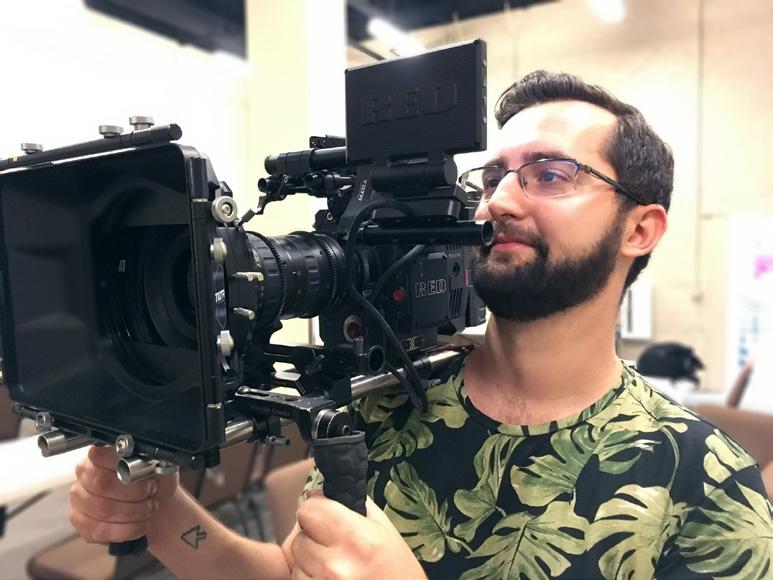
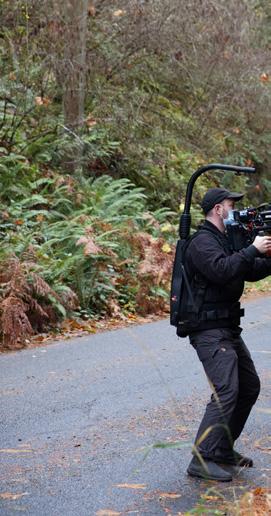

Associate Member Angel Navarro III with director Tricia Hagoriles on the set of a
Credit: Eric Milner

Director of photography and camera operator David Bercovici-Artieda (associate member) with key grip Shawn Montgomery in a “Louisiana swamp” shoot for the miniseries The Ruby Landry Saga on location in Vancouver Island.
Associate member Kyle K Chappell on day 10/25 in the IIHF World Juniors TSN Broadcast Bubble in Edmonton, AB.
Associate Member Bryce Zimmerman frames up a shot in Mount Work Regional Park on Vancouver Island for a Hoka One One commercial.

Credit: Kyle K Chappell


Behind the scenes of MELS mixed reality shoot, which brought the New York City and Paris skylines to the studio in Montreal.
Fresh off the heels of the Emmynominated The Mandalorian, interest in LED screen technology and virtual production (Mixed Reality) is increasing rapidly. Disney’s The Mandalorian – which was nominated for 15 Emmys and won awards for its cinematography, special effects, and production design – has proven that Mixed Reality, which combines virtual backgrounds with practical cameras and foreground lighting to produce in-camera VFX, is ready for the spotlight. Although the technology is still in its infancy, the production industry and filmmakers are adapting quickly. They have been abuzz with the possibilities, realizing the advantages in both costs and creative potential.
“Mixed Reality is the most groundbreaking, revolutionary breakthrough in maybe 50 to 70 years, and possibly since sound,” explains Greig Fraser, asc, acs, one of the cinematographers behind The Mandalorian, as well as Dune and Batman.
He continues, “When processed screens came out as a technology, that was sort of a breakthrough, but they looked a little hokey in the early days. I have major contentious issues with processed blue and green screens because they contribute nothing to environmental lighting. With Mixed Reality, everything around you is a lighting tool, just like when you are trying to light a set. We are at the infancy of where this technology will go, and it’s still possible to put a bounty hunter on a desert planet with an infant child. I’m always speculating about where this technology will be in 10 years and what it can do. We’re only at the beginning.” With the pandemic causing an acceleration in change, more and more production professionals are interested in learning about virtual production. As a result, studios have started building virtual production stages. Montrealbased MELS Studios launched their own virtual stage with an LED wall in late October, bringing together a customizable virtual production stage with their VFX department to offer a ready-made solution for filmmakers. “It’s a great new tool, but like anything new, it can be complex at the beginning because you are bringing different worlds together, and they need to understand how to work together,” explains MELS President Martin Carrier. Carrier came to MELS with more than 20 years of experience in the gaming industry and recognized the growing interest in virtual production. The stage he set up in Montreal can be scaled to meet the needs of filmmakers, complete with ARRI’s bestin-class remote heads, cameras, lights, and lenses. Although filmmakers have been abuzz about virtual production’s potential, the response was surprising. “One of many surprises was the enthusiasm from the ad-making world, who are just like, ‘You know what? We can’t travel right now. This is a great way to capture different locations on screen and deliver a great product.’ That was pretty surprising because we thought this is going to be a solution that’s limited to larger productions.”
Benefits Unlike a green screen, virtual production combines virtual reality LED screens in combination with practical production. The technique allows actors to interact with their surroundings and allows crews to make creative decisions. As Christina Wise, MELS Head of VFX, put it, “You’ve heard the saying, ‘We’ll fix it in post.’ Now we can fix it in prep.” “Although we do a lot of pre-viz, a lot of the time, you don’t get to see what the final product will look like while you’re working on it. You live in an imagined reality. With this technology, even if you decided to replace the background

(because we capture all the necessary information to do that), you’d still get a real sense of what the final product will be as you are shooting it. I think that’s interesting for the actors, for the directors, on so many different levels. You are interacting with what you are shooting instead of guessing,” explains Sara Mishara, a Montreal-based cinematographer who shot MELS proof of concept virtual stage production. Mishara, who has worked on more than 14 feature films, adds that the LED screens used in the background also emit realistic lighting on a subject. “For lighting, [virtual production is] a real game-changer because lighting is not just how light hits a face and reflects off of skin. The entire environment plays a role. I’m not even talking about the technical stuff like how its reflected off cars and windows but even the quality of light when you are in an outdoor situation. It’s very hard to reproduce that quality of lighting when you are in a green screen situation. The light that flows from an LED screen interacts with the local environment and results in a beautiful and naturalistic effect.” Another benefit, as Fraser points out, is travel. With the pandemic forcing many to curtail travelling, virtual productions offer filmmakers an opportunity to bring the location to you. Fraser says, “As a cinematographer, it gives me much more control than shooting in front of a blue screen. It gives me more control in other ways that aren’t even obvious. For example, if a production designer loves the look of a location that is impossible to get to, you can send a still photographer out to get photos and build this location virtually. It opens the door to hundreds of possibilities that we haven’t thought
ARRI’s Camera Stabilization Specialist Alan Lennox prepares the SRH-3 stabilized remote head to enable social distancing on set.
New stages like MELS Mixed Reality Production System bring the shooting location in-house and allow process optimization and social distancing.
about.” end of part i


All images courtesy of MELS
SHOOTING SCHITTTHE
Gerald Packer csc and David Makin csc Talk Comedy

hen Schitt’s Creek first premiered on CBC in January 2015 (see December 2014 issue), the Toronto Star called it “one of the best CBC comedies in years.” The pilot attracted more than 1 million viewers, and and disdainful to adapting to a simpler life with each other and without money. Critical acclaim and a 2017 deal with Netflix led to the show more than doubling its ratings and amassing more than 3 million viewers. The sixth and final season of Schitt’s Creek, which began airing in 2020, proved to be its most successful – at the 72nd Primetime Emmy Awards, held By Fanen Chiahemen Images courtesy of CBC Television W at the 2016 CSA Awards, the series took home more virtually due to the global COVID-19 pandemic, than half a dozen trophies, including Best Comedy the series made history by winning all seven maSeries, and Best Photography in a Comedy Program jor comedy awards, capping off a great run for cast or Series for Gerald Packer csc. and crew, including Packer, who shot Seasons One The show’s heroes – or rather antiheroes – the through Five, and David Makin csc, who shot SeaRoses, a once filthy-rich family of four now broke son Six. and forced to live in a run-down motel in a town Landing on Netflix was a game changer for the named Schitt’s Creek, which they once bought as series, Packer contends. “It was great for Canada; a joke, were portrayed by Eugene Levy (Johnny I think having the world audience on Netflix really Rose), Dan Levy (David Rose), Catherine O’Hara pushed it to another level,” he says. The mandate for (Moira Rose) and Annie Murphy (Alexis Rose). A the show, however, remained the same, according month after Schitt’s Creek’s CBC premier, it debuted to Makin. “As far as the cinematography, we were on U.S. cable channel Pop TV, and the show’s pop- there to shoot the actors being funny and try and ularity held over subsequent seasons, as the Roses make it not look like a brightly lit comedy,” he says. bloomed, so to speak, evolving from being shallow For Makin, shooting Season Six was “a different

kind of challenge as a DP, as it was not like starting a new show,” he says. “Because they weren’t replacing Gerald by any means. He was just off on another show and they had to bring somebody else in. They weren’t looking to change the look. They had their rhythm and their look and that was very clear to me. I had to go in there somewhat matching the look and the feel of the show, but at the same time subtly add my own aesthetic, as every DP is different.”
Having REDLAB’s Walt Biljan as the colour timer on all seasons was an asset. “Dan, Eugene, Walt and I came up with the look of the show and honed it every year,” Packer says. “My team, [operator] Kaelin McCowan, [operator] Johnny Colavecchia, [gaffer] Loreen Ruddock and my key grip Mitch Holmes were instrumental with their ingenuity and expertise through many of the seasons.” As the DP, the blockings were the most important part of each scene, Packer says. “Because the motel rooms were small, it limited the movement of the actors in the scenes. So we had to figure out how to keep things interesting with lighting and framing and to complete nine-plus pages a day,” he explains. “It was tricky because the bulk of it happened in those motel rooms, and they’re basically like one long bowling alley,” Makin
Catherine O'Hara (left) and Sarah Levy on the set of episode 609, Rebound, lensed by David Makin csc.
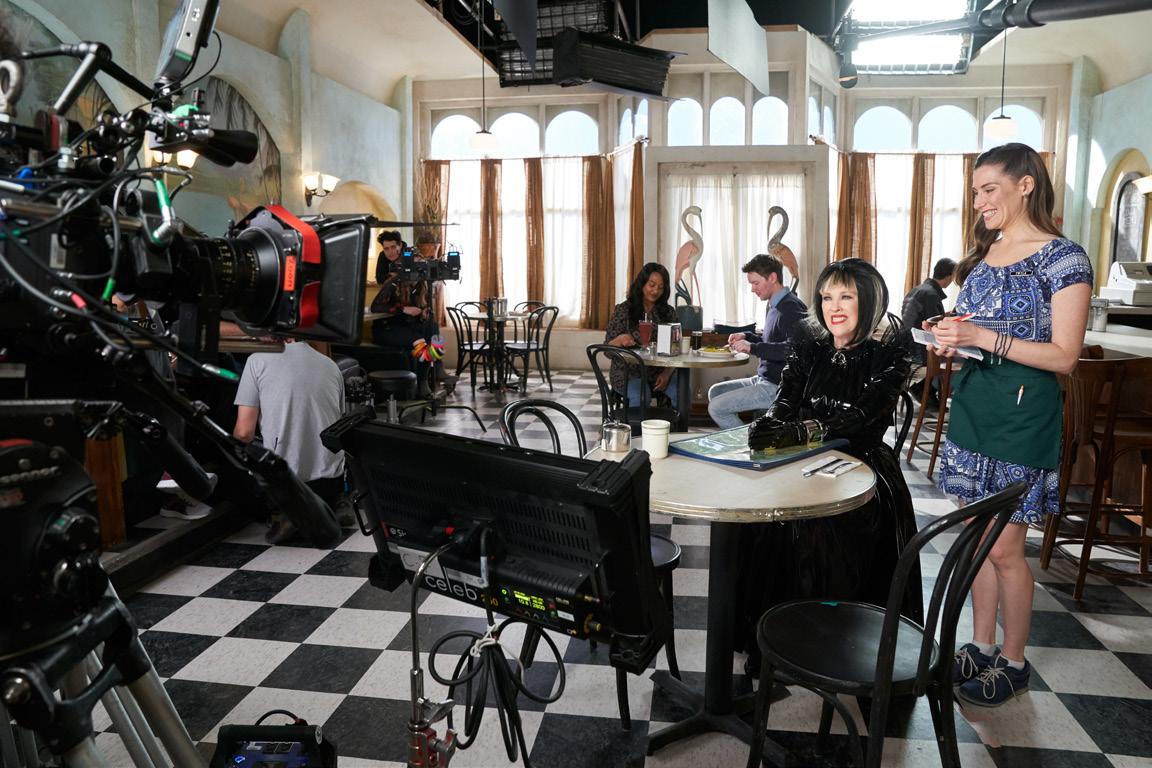
talented actors.” Gerald Packer csc

adds. “Just one long room with a little window at both ends and that’s it. So trying to get any sort of moulding or layering is challenging at the best of times. You can do it, but with the time restrictions and the amount of people in there, that kind of complicated lighting setup could take hours, and you just don’t have it to shoot 11 pages a day. You find the best compromise between lighting the room as best as you can with five or six people, running two cameras handheld while trying to make it all look realistic and not too bright and flat. “As I said, I didn’t change much,” he continues. “I think I added one or two practical lights on a dresser but even then, Dan was committed to continuity and would say, ‘That wasn’t there for five seasons, Dan Levy (left) and I don’t know if you can Emily Hampshire on put a light there.’ And I the set of episode replied, ‘Well, it’s okay, 609, Rebound, lensed it’s a hotel room. Some by David Makin csc. things can change, and if we put it there, at least there will be a bright spot in the frame, and it will help me motivate a light source from that corner.’ Very rarely could you shoot sideways and use the window as a lighting source. There’s no natural light moulding in there, it’s just whatever the practicals are.” It was well into preproduction before Makin found out that Season Six would be the last. “That made
Eugene Levy and Gerald Packer csc on the set of episode 106, Wine and Roses. (L-R) Eugene Levy, Catherine O’Hara and Chris Elliott in the episode 110, Honeymoon. (L-R) Eugene Levy, John Hemphill and Karen Robinson in episode 205, Bob’s Bagels. (L-R) Karen Robinson, Chris Elliott, Eugene Levy, Rizwan Manji and John Hemphill in episode 310, Sebastien Raine.
Annie Murphy in episode 601, Smoke Signals.
“We as cinematographers just service the story, and to do anything different would have been wrong. So it’s not to draw attention to the cinematography, it’s to try to draw
attention to the story.” David Makin csc





it interesting for me to see how they were going to wrap it up,” he says. “For my DP research, I watched the five seasons ahead and caught up on all the storylines, as well as Gerald’s lighting and camera technique.” That it would be an emotional season to shoot was undeniable. “I went to some of the table reads, and I remember Eugene coming out of the readthrough for the last two episodes and as he was shaking his head and grinning, he says, ‘I thought this was a comedy. Everybody’s crying in there.’ Even in the walkthrough rehearsal everybody was very emotional, and everybody was bawling.” The last scene they shot on stage was David and his partner Patrick’s wedding. “They figured they’d shoot it as the last scene so everybody was at their emotional height. I thought that was a good idea. It was very smart,” Makin says. “We figured we had to get as much cross coverage on the wedding as we could. We knew that Dan’s and Catherine’s characters would be the most emotional, so in the first setup of the nuptials we cross-covered with three cameras. We shot Dan’s coverage from Catherine, Dan’s coverage from his partner Patrick, and also Catherine’s split coverage back to Dan and to Noah [Reid]. It was a bit of a challenge, especially with Catherine’s bishop-styled headdress!” The talent and dedication of the cast left a big impression on both Packer and Makin. “It was amazing to watch Catherine and Eugene and just how they embraced everybody and every actor that was

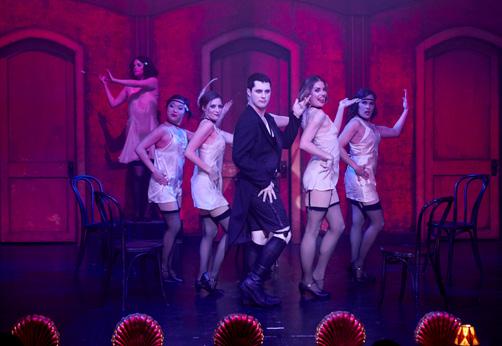
Catherine O’Hara and Eugene there,” Makin says. “It Levy on the set of episode wasn’t like they did a 401, Dead Guy in Room 4, performance and then lensed by Gerald Packer csc. walked off set and went to their trailers. They Scene from episode 514, were there most of the Life is a Cabaret. time. Eugene was there because he was a producer, and when he wasn’t on camera he was sitting by the monitors and chatting with everybody. I remember one day while we were adjusting the next shot, Catherine didn’t go anywhere, she just sat on one of the beds in the motel and we were all singing old TV theme songs with her.” Although Packer’s work on the series earned him two CSA Awards – in 2016 and 2018 – he credits the success of Schitt’s Creek to “good writing and good acting and really just talented Canadian actors.” “I think first off the success is just the writing and the heart, the fact that it went more towards the heart and the relationships,” Makin concurs. “We as cinematographers just service the story, and to do
anything different would have been wrong. So it’s not to draw attention to the cinematography, it’s to try to draw attention to the story.” “I don’t think they hired the DP on this show to be funny,” Packer jokes. “Comedy is what they do. We are there as cinematographers to capture the magic of all the talented actors. We’ve got our helpers like our gaffers, grips, lighting, camera and sound, and we all just try to capture the magic on the day, and it was really fun. It was great working with some really nice people, and that’s how I like to look at it. We were there, but it wasn’t because I’m funny.” Makin adds, “I can be funny… Back when I was shooting Kids in the Hall, the cast would tease me by saying, ‘David, you’re not funny. You know funny, but you’re not funny.’ I like to think that they were expressing what Gerald is saying. We’re not the funny ones. Our job is to know the funny and how best to capture it.”
Everybody’s crying in there.’ David Makin csc



Blackmagic Design raises the bar.
Blackmagic Design takes cinema production to stellar new heights with some recent updates to two of its most popular products. Already a game changer in editing software technology, the new DaVinci Resolve 17 ups the ante with hundreds of additional features and enhancements, including next-gen tools that give you greater creative control and a new high-performance audio engine that supports over 2,000 tracks and allows you to export multi-channel files and much more. And for a limited time, you’ll receive a Blackmagic Design Speed Editor keyboard at no extra charge with your purchase of the software. Anyone familiar with the amazing Ursa Mini Pro 12K cine cam will appreciate the version 7.0 firmware update, which includes substantially boosted frame rates, Blackmagic RAW stills capture support and broadcast lens connector support, plus support for 12K LUTs and 12K exposure metering in the viewfinder. Contact us at Vistek to find out more.
SEE BLACKMAGIC DESIGN CAMERAS AND PRODUCTION TOOLS AT VISTEK
On Thin Ice

Credit: Galafilm Productions
On Thin Ice
By Geoffroy Beauchemin


Main photo: Inuit guides at Ikpiarjuk (ᐃᒃᐱᐊᕐᔪᒃ) (Arctic Bay). This page top: Frame from Under Thin Ice. Bottom: Production crew on location at Ikpiarjuk (ᐃᒃᐱᐊᕐᔪᒃ) (Arctic Bay). F 1ilming in the Arctic is a cinematographer’s dream. Inquisitive eyes can discern the subtle hues on the pale landscape. If there are more than 100 Inuit language terms to describe snow and ice, in the digital world of bit(s), there is an infinite way to expose the pure shades of white in this remote part of the world. Polar bears appear very yellow on a sunny day but can quickly blend in with clouds, fog, snow or even rain. As observant as one can be while watching for bears, you have to look at yourself to see colour in a whiteout. Underwater is another planet. Whites turn into blue and green palettes that reflect on the ever-evolving sculptured icebergs. This colourful dream materializes like in a fourth dimension when your face descends into -1.4 Celsius water. From spring to autumn, 24 hours of sun with a never-ending sunset offer magical colours and contrast but is hard on the crew’s resting time. Documenting this vast area that regulates global temperature is a privilege that comes with worthwhile efforts, even in the most adverse conditions, especially when we know that the documented icescapes will probably have disappeared in the next few years. The responsibility to raise awareness is enormous in a context where the world’s attention is focused on an invisible enemy: COVID-19. The 10-year deadline scientists warned about before a tipping point in the climate chain reaction has been eclipsed in the media by a tiny virus. And it’s a shame. Looking back on making Under Thin Ice makes me realize how precious our freedom is, how fragile our survival has become. One should never take this liberty for granted! Feeling preyed upon by a polar bear for the first time is an experience that can put things into a steady focalpointed monochrome perspective. No one is wholly protected like we Credit: Galafilm Productions used to think. Odyssée sous les glaces originated in the mind of underwater cinematographer Mario Cyr while diving on assignment in the Arctic. After more Credit: Jean-Benoît Cyr/Galafilm Productions than 40 trips documenting wildlife at the poles for major broadcasters, he witnessed how climate change has transformed the land and seascape, profoundly affecting the lives of Inuit communities and the fauna that they depend upon. Hoping to invest his knowledge into a Canadian based

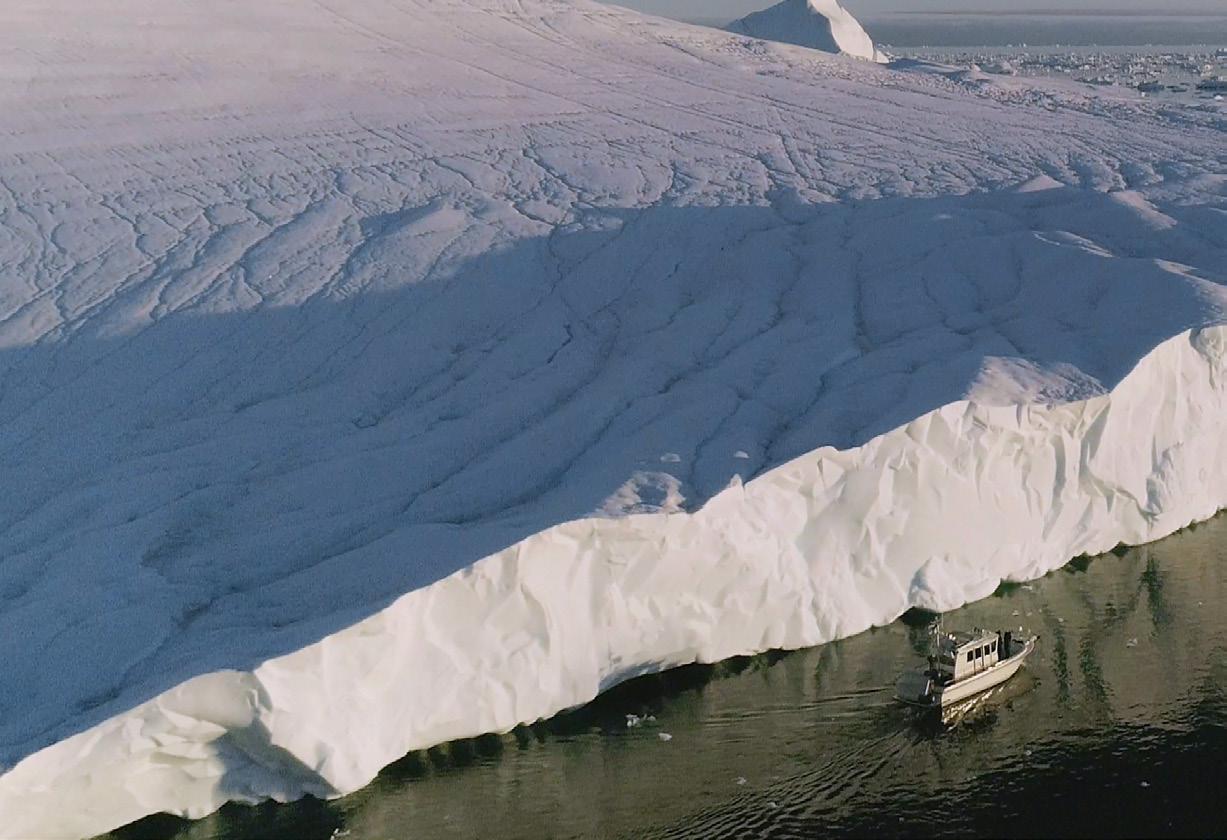
production, Mario and experienced Galafilm executive producer Arnie Gelbart put together a fantastic team to tackle the challenge of creating a quality production with a fraction of Blue-Chip project budgets. As lifeless as the frozen desert can seem, the goal was to expose this kingdom’s fragility and complex species’ interdependence. Helped by Inuit guides, Mario Cyr and expert cave diving cinematographer Jill Heinerth provided a human perspective as they courageously dive in hazardous freezing waters alongside icebergs, walruses, and polar bears. 1st AC Martine Leclerc did special preparation at MTL Grandé with whom we put together a “basic” camera package. To reduce costs and weight, we chose not to use any cranes or large stabilizers as we already had two ARRI Minis in Gates U\W housings and diving gear. For topside, one AMIRA was the primary camera with drones, a DSLR, and multiple GoPros. The Canon 50-1000 was a fantastic lens to capture polar bears without disturbing them and was used with a Fujinon 19-90 standard zoom lens. We later changed the AMIRA for a Sony F55 for its light weight and low power consumption. Everything was carefully packaged since the equipment would be exposed to water and long bumpy Ski-Doo and boat rides. The expectations were high, and the window of opportunity small. Prioritizing wildlife documentation, plans were changed daily as dictated by mother nature and the striking reality of melting ice. We made two trips to the Canadian Arctic and one to Greenland of around 10 to 12 days each. Usually, the norm on nature documentaries is double or triple this time. Weather, visibility and animal encounters are all elements that can prolong a schedule and bust a budget. Most days started around 1 p.m. and finished at around 3 to 4 a.m. to get the best light. The first segment, in Arctic Bay, was the hardest. Compared to the previous year, water spread over the ice one month earlier. Set up a week
Geoffroy Beauchemin in Naujaat, Repulse Bay Naujaat (ᓇᐅᔮᑦ) Nunavut. In Ikpiarjuk (ᐃᒃᐱᐊᕐᔪᒃ) (Arctic Bay). An iceberg in Ilullisat, Greenland. Belugas swimming in Ikpiarjuk (ᐃᒃᐱᐊᕐᔪᒃ) (Arctic Bay).

before, our basecamp was drenched in pools when we reached it. Tents had to be moved to remaining “islands” of snow and ice. We took care of all the camping chores. Cooking for ourselves and our three Inuit guides added to the already busy schedule, but warm food was the best reward after a hard day’s work. Director Denis Blaquière, a former comedian, made us laugh and helped keep good spirits while juggling the busy schedule in fluctuating weather. Still photographer Jean-Benoit Cyr worked long hours with data wrangling. He also helped with camera equipment as I had no official AC on location. Jill Heinerth, the only woman within the sixperson group, was always cheerful and courageous, no matter what situation arose (even when peeing overboard a rocking canoe). Soundman Marco Fania helped us discover the unusual sounds of four different mammals singing together with a hydrophone (a sequence that didn’t make it to the edit).

Credit: Jean-Benoît Cyr

Credit: Jim Heinerth

Credit: Galafilm Productions

Credit: Galafilm Productions
This sonorous symphonic image was very inspiring when shooting topside and underwater. The silent world beneath the ice is not quiet at all! Over the ice, at the floe edge, the quality of silence is exceptional. Being able to clearly hear the blows of narwals and belugas helped locate them to get the shots. Even the delicate swishing sound of feathered creatures could be heard from afar. As a cinematographer, I’ve always paid particular attention to sound, a dimension so crucial in documentary filmmaking as we often frame according to what is heard. My father, Serge Beauchemin, a retired soundman, must have transmitted his genes. “See with your ears and hear with your eyes,” I often heard. In Greenland, we spent most of our shooting time on a small but comfortable boat searching for whales and a safe iceberg to dive around. The drone was the perfect tool to capture the vast field of floating mountains. Because we were so close to the magnetic pole, I had to pilot in full manual mode with no compass or automatic return to home function, particularly stressful when flying in and out of a moving boat with no landmarks. The aerial camera, however, was the best way to frame-up the action and display impressive shapes of icebergs. With limited time and reduced underwater visibility, we often documented the reality of nature filmmaking with all its difficulties. Reaching our last destination, White Island, was particularly challenging. When we finally spotted walruses after searching for six days around the island, murky waters made it too dangerous and impossible to film them underwater. Pole cams were useful but gave a limited perspective. This deception was overcome by the numerous polar bears we encountered on and around the island. Luckily, near-perfect conditions made the underwater bear swim-by shot possible with everyone hoping for the divers’ safe return. Later that night, we celebrated the exploit around fresh arctic char prepared by our Inuit chef Nina Malliki. This time nested inside a bay, our basecamp was on solid ground with prospector tents. Our guide Solomon Malliki provided a tiny wooden shack where the crew slept side by side in sleeping bags. The plywood walls gave a sense of protection from the ravenous polar bears roaming around. It’s an advantage to have your subject come to get their closeup! We did have to scare them away a few times. The giant mosquitoes were by far the most annoying, sometimes in too excessive numbers to do an interview or even a wide shot. From selling the concept to shooting it and creating a story with the dailies, nature documentary filmmaking can sometimes be a dangerous adventure. But as unpredictable as this process can be, when everyone does their best, there can be no regrets. Even with the best preparation done by coordinator Gloria Straccini, achieving our goals would not have been possible without the local Inuit peoples’ precious guidance. Behind the film lies an incredible human-nature adventure from which we all learned about our limits and the fragility of our planet. Screening the final result was very gratifying and confirmed yet again the talent of editor Alain Belhumeur. He used the best material, working with producer-writer Natalie Dubois and the director, to compose a story that cannot leave the viewer indifferent. I also want to acknowledge the work of Noé and Christian Sardet for their amazing macro shots of the invisible aquatic life. Colourist Claire Deruelle carefully took on the challenge of harmonizing different sources for the final touch. Because of the pandemic, the year 2020 will have left a space in cinematographic productions, in a time when documenting nature’s changes has never been more critical. As much as science can warn the public with facts and predictions, humans need to be deeply touched to better integrate the situation’s gravity. Anthropocene is a reality. Hopefully, films like Under Thin Ice will help raise global consciousness about the fate awaiting our children if business goes on as usual.







